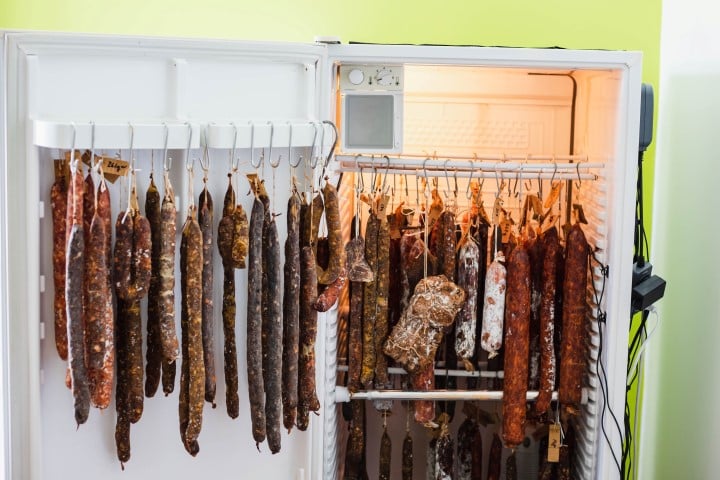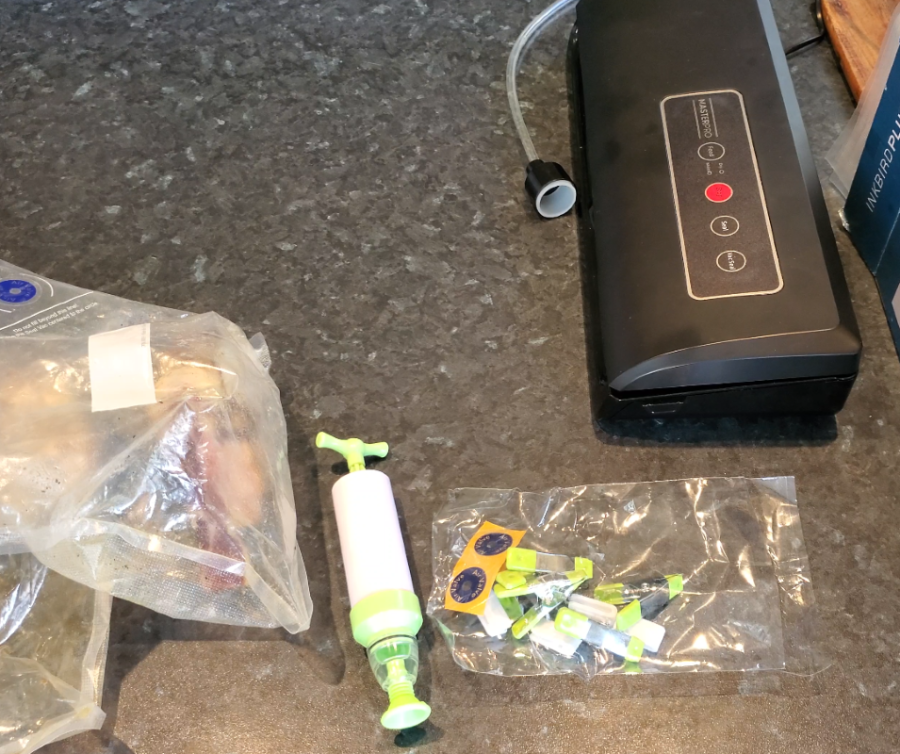The way you store cured meat really depends on the type of cured meat you’ve got. A whole bone-in prosciutto is not the same as deli ham slices. If you treat them the same, you either dry them out to the point they’re tough, or you let them spoil faster than they should.
I’ve spent years making and buying cured meats — everything from traditional whole-muscle dry-cured cuts (prosciutto, pancetta, bresaola, coppa) to smoked ham, salami, and pastrami. I’ve also vacuum sealed them, hung them, frozen them, and, in a few cases, accidentally ruined them. So this guide is what’s actually worked for me.
The goal with storage, always, is simple: keep the meat tasting good for as long as possible without letting it dry out, turn slimy, or go sour. That mostly comes down to oxygen, temperature, light, and surface area.
How to Store Cured Meats
Different styles of cured meat are preserved in various ways.
Some are salt-cured and dried over months with slow moisture loss. Some are cooked and smoked. Some are brined. The way you store them changes with that process.
Before we go into specific categories like prosciutto, salami, smoked ham, and pastrami, I want to cover the core rules that apply to all of them. These basics will explain why certain meats can hang in a cool pantry and others really do need the fridge.
Core Rules for Storing Cured Meats
Oxygen Exposure
Oxygen is usually the enemy. When cured meat is exposed to air, two things start happening fast:
- It oxidizes, especially the fat, which can go rancid and taste stale or even slightly sour.
- It dries on the cut faces, which turns the meat leathery.
This is why a whole, uncut piece of cured meat lasts dramatically longer than slices. As soon as you slice, you’ve created a lot of fresh surface area and you’ve let the oxygen rush in.
Surface Area (Whole Piece vs Sliced)
One thick whole muscle like coppa or pancetta is basically protected by its own outside surface. It’s dried and sealed. Inside, it’s still rich and supple. That can hold for a long time in the right environment.
A pile of thin slices of that same pancetta is the opposite: lots of exposed edges. Those edges dry, oxidize, and lose aroma quickly. You’ll notice this especially with salami that’s already been sliced — it turns dull and greasy faster than a whole uncut salami.
So: whole lasts, sliced fades. That’s the pattern you’ll see again and again.
Light, Heat, and Rancid Fat
Fat in cured meat is one of the best things about it — sweet, silky, and full of flavor. It’s also the most fragile part. Direct light and warm temperatures can make the fat turn yellow and taste rancid. I’ve seen this with guanciale that someone tried to “display” in a sunny kitchen. It was still technically edible, but it didn’t taste right anymore.
So even for meats that are traditionally hung at room temperature (like prosciutto legs in Italy, or speck in parts of Europe), that doesn’t mean “put it by the window.” It means: cool, shaded, not hot, not in direct sun, and not somewhere where the fat is going to start melting.
Fridge vs Cool Room vs Freezer
Here’s where people get confused. Some cured meats are preserved by salt and drying. Others are cooked and just flavored with smoke. Those are two totally different worlds.
- Dry-cured whole muscle meats like prosciutto, pancetta, coppa, culatello, bresaola — these are salted and slowly dried. Traditionally, a whole uncut piece can be stored for long periods in a cool environment, not hot, and not exposed to sun. They’re not cooked; they’re preserved.
- Dry-cured salami is similar in that it’s fermented, salted, and dried. But because it’s made from ground meat, it’s more exposed internally and tends to age/fail faster once cut.
- Smoked ham and pastrami are usually brined and then cooked (hot smoked, steamed, baked). Cooked meats behave more like leftovers. They don’t get the same “hang it in a cellar for months” treatment. These refrigerated meats are more perishable.
Freezing is always an option if you do it right. For sliced ham or sliced pastrami, I’ll freeze the slices individually first so they don’t stick together in one solid lump. I’ll walk through that method in detail later in the article. It makes pulling out just a few slices way easier.
Vacuum sealing or getting as much air out of the bag as possible is what changes the game in the fridge or freezer. With whole cured meats, I’ve kept vac-packed pieces in chilled storage for a very long time without quality falling apart. The less oxygen around the meat, the slower the visible change.
Storing Whole-Muscle Dry-Cured Meats
Whole-muscle dry-cured meats are the classic traditional cured cuts. These are salted, sometimes seasoned with herbs or spices, and slowly dried until the perfect balance of flavor and preservation is reached. If you’re new to this world, it helps to first understand what dry-cured meat actually is — these meats aren’t cooked, but carefully preserved through salt and time.
What Counts as Whole-Muscle Dry-Cured Meat
When I say whole-muscle, I mean individual cuts, not ground and stuffed like salami. These cuts are cured with salt and aged over weeks or months until safe and shelf-stable. The methods for curing meat with salt are the foundation for everything in this category. Without salt, proper airflow, and time, these meats wouldn’t develop their depth of flavor or longevity.
- Prosciutto (whole leg)
- Pancetta
- Coppa / Capocollo
- Guanciale
- Bresaola
- Speck
- Culatello, Spalla, Lonza
You’ll see these hanging proudly in delicatessens across Italy and Spain. That’s not for decoration — it’s the proper way to store them. Cool, shaded, and well-aired spaces are key to maintaining quality without refrigeration.
How to Store a Whole Piece
If I’ve got a whole chunk of pancetta, coppa, or bresaola, here’s how I handle it. The goal is to maintain its ideal moisture balance and protect it from light and heat. Light, in particular, is the enemy — it oxidizes fat and turns it yellow. That’s why I never hang cured meats in the kitchen or near a window.
- Keep it cool, not hot. A mild cellar, basement, or shaded pantry around 10–15°C (50–60°F) is perfect.
- Avoid bright light. Direct sunlight accelerates rancidity and spoils delicate fat flavors.
- Skip the fridge unless vacuum-packed. Refrigerators are too dry and can make the outer surface tough. If you vacuum seal it, though, the environment becomes stable enough for long storage.
Traditional hanging environments are designed to maintain a balance between airflow and humidity. In regions like Parma, Italy, whole prosciutto legs hang for months at steady conditions. The Parma Consortium’s official prosciutto storage guide explains how these natural conditions preserve flavor and safety over time.
I’ve also had success vacuum sealing entire cured pieces for long-term storage in the fridge. The lack of oxygen prevents surface drying and preserves color. Some of my sealed pancetta and lonza have stayed excellent for over two years. As long as there’s no air inside and the fat hasn’t oxidized, the quality holds up incredibly well.
If you don’t have a vacuum sealer, try the water-displacement method — place the meat in a strong zipper bag, submerge it gently into a pot of water (leaving the seal slightly open), then close it as the water pushes the air out. It’s an old chef’s trick that mimics vacuum sealing. If you want to go deeper on how temperature and moisture affect this process, check out USDA guidelines for cured and smoked meat storage.
How to Store Slices from That Same Piece
Once you slice that pancetta, prosciutto, or coppa, everything changes. You’ve exposed new surface area and invited oxygen in. Sliced cured meat deteriorates far faster than whole pieces — that’s why I’m careful to store mine properly and only slice what I plan to eat soon. You can read more about how to thinly slice cured meat properly if you want to improve how your slices hold up and taste.
- Short-term: Keep slices in an airtight container in the fridge and use them within a few days.
- Freezing: Works surprisingly well because these meats have already lost 30–50% water during curing. Less water means fewer ice crystals and better thawed texture.
- Fridge placement: Store in the lower section, where temperature stays most stable and moisture is slightly higher.
When you do store sliced meats in the fridge, wrap them tightly and keep the air exposure minimal. Vacuum-sealing slices is best, but reusable sealing bags also work well. If you’re unsure whether to refrigerate or not, my full guide on whether cured meat should be kept in the fridge explains how to handle different cured meat styles safely.

Storing Dry-Cured Salami
Dry-cured salami follows the same preservation principles as whole-muscle meats, but because it’s made from ground meat, it has more exposed surface area inside. That means it can lose quality faster once cut. Still, properly cured salami can last for months if handled the right way.

Examples of Dry-Cured Salami
Classic regional styles of dry-cured salami include Felino, Milano, Soppressata, Cacciatore, and Spanish-style salchichón. These all rely on methods for curing meat with salt to draw out moisture and create a stable environment for fermentation and drying.
How to Store Whole Salami
If you have a whole, uncut salami, you can store it much like a whole pancetta or coppa. Hang it in a cool, dark area with steady air movement. The ideal range is about 10–15°C (50–60°F). Avoid humidity extremes; if it’s too dry, it hardens, and if it’s too damp, mold can get out of control.
When I’ve made my own salami, I often keep it wrapped loosely in paper inside a curing chamber or a cellar-type space. The casings breathe, preventing condensation. If you need to refrigerate, wrap in butcher paper first — don’t trap moisture by sealing it in plastic unless you’re vacuum-packing.
How to Store Sliced Salami
Once opened or sliced, salami loses protection from its casing and dries out quickly. I’ve found that refrigerating it in a sealed container keeps it fresh for about a week. Whole, uncut salami lasts far longer — sometimes several months if humidity and temperature are stable.
- Store sliced salami airtight in the fridge for up to a week.
- At room temperature, keep it out only for short serving periods.
- Vacuum packing extends freshness and slows oxidation.
If you’ve opened a vacuum-packed salami from the store, reseal or wrap it tightly again after each use. Once oxygen gets in, even refrigerated salami can darken, lose aroma, and get a greasy surface. When that happens, it’s time to move on to a new piece.
Storing Smoked Ham
Smoked ham sits somewhere between cured and cooked. It’s typically wet-brined, smoked at a moderate temperature, and then stored chilled. Unlike dry-cured meats, smoked ham isn’t shelf-stable — it needs refrigeration. If you want to understand the difference in preservation style, I’ve broken it down in my guide on dry-curing vs wet brining for meat curing.
Store-bought hams often include added water or preservatives to stay juicy. Homemade or traditionally smoked hams usually contain less moisture but should still be kept cold to prevent spoilage. Treat all cooked smoked meats like you would leftovers — safe when cold, risky when left out.
Whole Smoked Ham
For a whole piece of smoked ham, refrigeration is essential. If it’s vacuum-packed, leave it sealed until you’re ready to serve. If you’ve made your own, wrap it tightly in plastic or butcher paper to limit oxygen exposure.
- Whole vacuum-sealed hams keep up to three weeks refrigerated.
- Opened or loosely wrapped hams last about a week.
- Always check for a “use by” or “best before” date — they take precedence over any general timeframe.
For food safety confirmation, you can refer to USDA guidance on storing cured and smoked meats. They outline safe refrigeration and freezing durations based on different curing and cooking levels.
Sliced Ham
When I slice ham, I freeze individual slices flat on a tray first — just like I do with bacon. Once frozen, they can be bagged together without sticking. This makes it easy to defrost only a few pieces at a time without thawing the whole batch.
- Lay slices flat on baking paper.
- Freeze until solid, then bag and label.
- Thaw slowly in the fridge to preserve texture and moisture.

Even with careful wrapping, sliced ham won’t keep long in the fridge once opened — usually around a week. Beyond that, the surface texture starts to change and the fat can take on a sour smell. Always trust your senses before reusing it.
Storing Pastrami and Other Cooked or Hot-Smoked Meats
Pastrami is a perfect example of a cured meat that’s also cooked. It starts with a wet brine cure, then gets hot smoked or steamed until fully cooked. That makes it more like a ready-to-eat roast — it’s flavorful and aromatic, but not preserved the way a dry-cured product is.
I’ve made pastrami from beef, venison, and even wild game like Himalayan tahr. No matter the meat, once it’s cooked, it must be kept cold. These types of meats simply don’t have the water loss or low activity levels that make dry-cured meat safe to hang.
Whole Pastrami
Whole pastrami should always be wrapped and refrigerated. If vacuum-sealed, it’ll last a week or more. Opened pastrami should be used within five to seven days. Vacuum sealing or tightly wrapping again after slicing helps extend that slightly.
Sliced Pastrami
Sliced pastrami can also be frozen using the tray method mentioned earlier. Freeze in single layers, then bag it once solid. That way, you can defrost a few slices as needed without thawing the entire pack. It’s simple, efficient, and keeps the flavor intact.

If you’re vacuum packing, label and date every package. Even though pastrami freezes well, texture can shift slightly if kept too long. My rule of thumb: eat frozen pastrami within three months for best quality.
For ongoing fridge storage or leftovers, you can also review my full guide on whether cured meat should be kept in the fridge — it covers where and how different cured styles hold best once opened.
Expert Tips for Longer Storage
Over the years, I’ve picked up a few habits that make a huge difference when storing cured meats. These tips apply whether you’re dealing with homemade prosciutto or store-bought salami — small changes in handling can double or even triple the shelf life without affecting flavor.
- Use reusable vacuum bags. I prefer them over single-use rolls. They’re slightly less airtight over time, but the reduced waste is worth it, and they still remove enough oxygen to slow spoilage.
- Try the water-displacement trick. Submerge your zipper bag in water to push out air before sealing. It’s simple, cheap, and almost as effective as a proper vacuum sealer.
- Keep portions small. Don’t store a kilo of sliced salami in one pack. Divide it into smaller bags so you only open what you’ll use in a few days.
- Wrap cured meats in paper, not plastic. Butcher paper or waxed paper lets them breathe while still limiting drying. This helps avoid that hard, tough outer layer caused by over-drying in plastic wrap.
- Always refrigerate sliced meats. Even the most perfectly cured meat will go off quickly once cut. See my guide on whether cured meat should be kept in the fridge for detailed storage comparisons.
Alternatives & When to Freeze
Freezing cured meat is not traditional, but sometimes it’s the best option — especially when you’ve made a big batch or want to store sliced meats long term. Done properly, freezing causes little to no flavor loss.
- Freeze sliced portions separately. Place slices on a tray until solid, then bag. This avoids clumping and makes defrosting easier.
- Label and date every bag. That helps track how long it’s been frozen and ensures you rotate older stock first.
- Thaw slowly. Defrost overnight in the fridge to keep texture consistent and prevent condensation from forming on the meat’s surface.
- Avoid freezing prized dry-cured hams like prosciutto di Parma. They lose too much delicacy in texture. Traditional guidance from the Parma Consortium still recommends cool, dry storage over freezing for these long-aged cuts.
Can I leave prosciutto out or does it go in the fridge?
Whole traditional prosciutto legs are designed to hang in a cool, shaded place at moderate temperature — not in direct sunlight or heat. Once sliced, prosciutto should always be refrigerated in an airtight container and eaten within a few days.
How long does opened salami last?
Once opened or sliced, salami usually keeps about a week in the fridge if stored airtight. Whole uncut salami lasts much longer in a cool, dry environment. If it starts to feel greasy, tacky, or smells sour, it’s time to discard it.
Can I freeze sliced ham or pastrami?
Yes. Freeze slices individually on a tray first, then transfer to a freezer-safe bag. This way they don’t clump together, and you can defrost only what you need. Thaw in the fridge for best texture.
Have a question or tip about storing cured meats? Drop it below in the comments — I reply to every one.

Tom Mueller
For decades, immersed in studying, working, learning, and teaching the craft of meat curing, sharing the passion and showcasing the world of charcuterie and smoked meat. Read More
